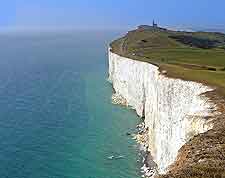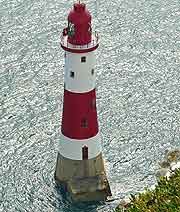Eastbourne History Facts and Timeline
(Eastbourne, East Sussex, England)

Eastbourne is best known as a fashionable Edwardian seaside resort. However, the history of this southern English town stretches back much further. It is known that from 500 BC, there was a Celtic settlement in Eastbourne and on the South Downs above the town. It's also thought that a Roman lord lived here, thanks to evidence of a particularly impressive villa.
Eastbourne's name is derived from 'Burne', the stream that ran through what is known as Motcombe Gardens. 'Burne' later became 'Bourne'. The town's name was prefixed by 'East' during the 13th century, to avoid confusion with nearby West Bourne.
From Medieval Times
At the time of the Norman invasion, Eastbourne was nothing more than a simple farming village. It is known that in 1324 King Edward II paid a visit and Eastbourne began to prosper. By the mid 16th century, it was in the ownership of three wealthy Sussex families - the Burtons, Gildredges and Selwyns. Most of the town's residents lived around present-day South Street, in the Meads and in an area known as Sea Houses.
From the 17th century, Eastbourne was the venue for many sea battles. The arrival of the French Emperor Napoleon Bonaparte on the scene in the late 18th century caused much consternation here. A series of fortifications known as Martello Towers were built along the coast. In 1805, a new fortress was built to contribute to the town's defences.

A Seaside Resort
Eastbourne was relatively slow to transform itself into a seaside resort. When King George III sent his children to Sea Houses in 1780, it was still just a busy fishing village.
It's thanks to the arrival of the railway in 1849 that Eastbourne owes much of its popularity. The town's owners at that time were William Cavendish, later to become the seventh Duke of Devonshire, and John Davies Gilbert. They planned to develop the area - at whatever cost. Their plans came to fruition in 1860, when a series of improvements were made, including spacious boulevards and streets, as well as a promenade. Later, the Meads was added, along with a proper town drainage system and Devonshire Park.
The Winter Garden was opened in 1875, shortly after the pier. Perhaps most notable of these plans was that no shops were to be built along the seafront - this is still true today. In 1883, Eastbourne became a municipal borough. Just three years later, the new Town Hall was opened. Built to luxurious standards, its lavatories were even graced by Minton tiles.
20th-Century History
In 1903, the town launched its very own motor bus company - making it the first of its kind in the world. Eastbourne buses operated between the Old Town and the Eastbourne Railway Station.
The Second World War brought many refugees to Eastbourne, although eventually the town itself had to be evacuated because of the threat of air raids. Indeed, nearly 4,000 incendiary bombs fell on the town during the course of the war.
Today, Eastbourne remains a traditional holiday town. In more recent times, it has also diversified to become a busy business and conference centre.
 Eastbourne is best known as a fashionable Edwardian seaside resort. However, the history of this southern English town stretches back much further. It is known that from 500 BC, there was a Celtic settlement in Eastbourne and on the South Downs above the town. It's also thought that a Roman lord lived here, thanks to evidence of a particularly impressive villa.
Eastbourne is best known as a fashionable Edwardian seaside resort. However, the history of this southern English town stretches back much further. It is known that from 500 BC, there was a Celtic settlement in Eastbourne and on the South Downs above the town. It's also thought that a Roman lord lived here, thanks to evidence of a particularly impressive villa.